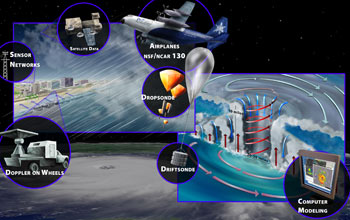Multimedia Gallery
Illustration of Hurricane and Research Instruments
The 2006 Atlantic hurricane season ended on Nov. 30, and despite earlier predictions of an active season, this one was one of the mildest in recent years. It produced only nine named tropical storms and five hurricanes, and only two of the tropical storms reached the U.S. mainland, neither causing significant damage.
From hurricane hunters flying through the eye of a storm to scientists analyzing the data to create more accurate models, National Science Foundation (NSF)-supported researchers seek a better understanding of hurricane dynamics. They use a myriad of instruments equipped with sensors that measure such factors as wind speed, temperature, humidity, pressure and more. To study how hurricanes form, driftsondes--high-flying, specialized balloons equipped with hundreds of instruments--are released from the west coasts of Africa and Europe, to float across the ocean. The driftsondes and also airplanes such as the NSF/NCAR C 130 can release smaller, parachute-equipped instruments called dropsondes that monitor the hurricane from within. On land, scientists drive mobile radars known as a Doppler on Wheels into the midst of a storm. Adaptive sensor networks are being developed to see how a storm changes as it comes ashore. All of this data is eventually used to create better computer simulations and models, in the hope of giving us better predictions of hurricane formation, path and intensity.
Credit: Nicolle Rager-Fuller, National Science Foundation
Images and other media in the National Science Foundation Multimedia Gallery are available for use in print and electronic material by NSF employees, members of the media, university staff, teachers and the general public. All media in the gallery are intended for personal, educational and nonprofit/non-commercial use only.
Images credited to the National Science Foundation, a federal agency, are in the public domain. The images were created by employees of the United States Government as part of their official duties or prepared by contractors as "works for hire" for NSF. You may freely use NSF-credited images and, at your discretion, credit NSF with a "Courtesy: National Science Foundation" notation.
Additional information about general usage can be found in Conditions.
Also Available:
Download the high-resolution JPG version of the image. (508 KB)
Use your mouse to right-click (Mac users may need to Ctrl-click) the link above and choose the option that will save the file or target to your computer.

